
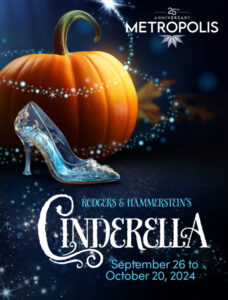 *** For years, Rodgers and Hammerstein’s “Cinderella” has been due for a makeover. The original book by Oscar Hammerstein II starred a Cinderella who was valued for her physical beauty as well as her kindness, but it didn’t seem to matter whether she had a thought in her head. Contemporary culture, however, has deemed it essential for a beauty queen to also have an interest in expressing her own opinions and in wanting to make the world at-large a much better place. (Think about the qualifications for Miss America!) Hence the new book by Douglas Carter Beane is a refreshing take on this classic fairy tale and the popular 1957 musical. Beane modernizes the story by adding some jokes and contemporary references plus several subplots not in the original. My guest adored this version: She laughed at all the gags and thought that the reconceptualization of the story was clever. In contrast, I found most of the added subplots to be unnecessary and the show to be much too long and drawn out, especially the second act. At the very least, the new adaptation ought to strike a better balance between its various threads.
*** For years, Rodgers and Hammerstein’s “Cinderella” has been due for a makeover. The original book by Oscar Hammerstein II starred a Cinderella who was valued for her physical beauty as well as her kindness, but it didn’t seem to matter whether she had a thought in her head. Contemporary culture, however, has deemed it essential for a beauty queen to also have an interest in expressing her own opinions and in wanting to make the world at-large a much better place. (Think about the qualifications for Miss America!) Hence the new book by Douglas Carter Beane is a refreshing take on this classic fairy tale and the popular 1957 musical. Beane modernizes the story by adding some jokes and contemporary references plus several subplots not in the original. My guest adored this version: She laughed at all the gags and thought that the reconceptualization of the story was clever. In contrast, I found most of the added subplots to be unnecessary and the show to be much too long and drawn out, especially the second act. At the very least, the new adaptation ought to strike a better balance between its various threads.
Molly Bremer does as remarkable job as Cinderella, with her mellifluous voice and beautiful acting: worthy of a Broadway production! The show is worth seeing just for her singing and acting—and, of course, for Rodgers and Hammerstein’s lovely music and catchy lyrics. The strength of Bremer’s performance cannot be topped! I also enjoyed watching Mitzi Smith, who plays Madame, the wicked stepmother. The humorous lines she speaks are a nice addition to the basic story. When she becomes mean and funny at the same time, her cruelty is toned down a bit, which is important for younger members of the audience.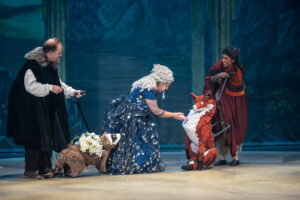
Of course, we are all familiar with the classic fairy tale, a story that still works well today when little girls might dream of marrying their handsome prince. Cinderella, a sweet young woman, is treated miserably by her stepmother and her two stepsisters, who turn her into their domestic servant. Her only comfort is sleeping by the fireplace and reading books. In the current version, her stepsisters are named Gabrielle (Maura Fawley) and Charlotte (Abbey Loria). We all know that Cinderella meets the prince (Patrick Johnson) at a ball with the assistance of her fairy godmother (Rachel Carreras). But here (spoiler alert) the fairy godmother is actually a poor woman named Marie, who is already known to Cinderella and lives in the woods.
One of the added subplots has to do with the character of Sebastian (Peter Briceño Gertas), a regent who has surreptitiously usurped royal power. The whole time that the prince was underage, Sebastian took land away from the citizens and treated the poor miserably. It is the character of Jon Michel (Luke Nowakowski) who is well-educated and who rallies the townspeople to stand up to the injustices being done to them. I’m not sure whether the quest for democracy and a constitutional monarchy ought to be inserted into this particular tale, but if so, then the music needs to reflect this. There would have to be least one or two new songs added about politics or poverty or human rights in order to propel the story forward. (Think about the musical “Mary Poppins.”) Some time is also spent in this production on the value of kindness. While the emphasis on being kind is a fine message to impart to young children (and all of us, for that matter), the adult in me found some of this to be too manipulative and phony. I won’t ruin the other subplots for you, except that one of them has the audience talking during intermission… having to do with the glass slipper that has accidentally fallen off Cinderella’s foot. From that point forward, the main plot, in my opinion, was affected adversely.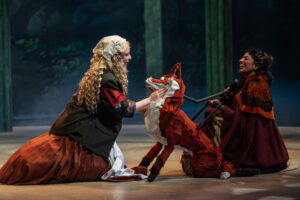
Director Johanna McKenzie Miller has done a fine job coordinating all of the action with so many characters taking the stage. The choreography in this show is extremely noteworthy, the province of associate director and choreographer Mandy Modic. Then too, the work of puppets and special effects designer Patrick McGuire is incredible! I especially enjoyed seeing how well the red fox and the raccoon are portrayed. What I liked most about Taylor Pfenning’s costume, wig, and makeup design is that the garments are easy-breezy: The men didn’t have to wear tights and the women didn’t have to wear corsets. In fact, the styles are not necessarily rooted to any one time period. For example, the stepmother’s dress is some combination of the Renaissance and Laura Ashley, whereas the stepsister’s dresses consist of long modest dresses that could have been worn in the 1950s. And of course, the costuming of Cinderella with her shimmering gowns is every little girl’s dream!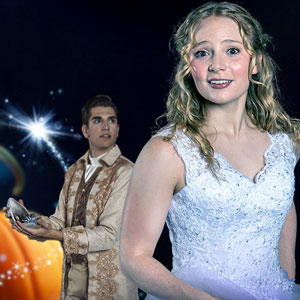
A multi-purpose set is designed terrifically by Lauren Nichols. I loved the seven arches in the background and five arches in the middleground: forming a total of twelve arches, corresponding to twelve hours on the clock, leading up to midnight. There was a clock dial on the floor of the stage as well. But with the exception of a few props being moved into a scene, we had to use our imagination throughout to define settings. Lighting design by Alexa Wiljanen is done extremely well, such that various colors of lights define the exterior space and indicate different times of day. The fifteen-piece orchestra led by conductor and music director Aaron Kaplan is wonderful as are the orchestrations by Danny Troob. I need to add that the sound effect of the dragon is much too loud and jarring. And I had to wear earplugs during the entire show.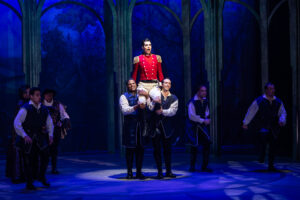
While the original book may have been dated and sexist, its conciseness and precision work well, especially with Rodgers and Hammerstein’s music. This does not mean that the story was not in need of some revision. But why must there be a banquet in addition to a ball? Why must there be multiple romances? Too many subplots distract us from the prince looking into Cinderella’s eyes and seeing a person of good character. Making everything so politically correct takes something away from the romance of the musical, the ideal of the solidity of marriage, and the famous ending of “they lived happily ever after.” I would have revised the script very differently. Then again, my guest absolutely loved the remake!
Rodgers & Hammerstein’s “Cinderella” is playing through October 24, 2024, at the Metropolis Performing Arts Centre, 111 W Campbell Street, Arlington Heights, Illinois.
Appropriate for Ages 5+ | Children under 3 will not be permitted.
Duration: 2 hours and 10 minutes with one 15–minute intermission
Tickets: Regular A-level $49, Regular B-level $45, Students $24
 Performance Schedule:
Performance Schedule: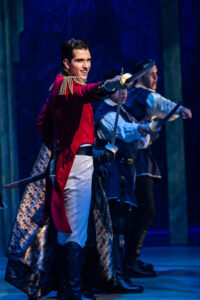
Thursdays and Fridays – 7:30 p.m.
Saturdays – 2:00 p.m. and 7:30 p.m.
Sundays – 2:00 p.m.
Additional performance: Thursday, October 3rd – 2:00 p.m. matinee
Accessible Performances:
American Sign Language performance: Thursday, October 3, 2024 at 7:30 p.m.
Open Caption performance: Saturday, October 19, 2024 at 2:00 p.m.
For more information and to purchase tickets, call the box office at 847-577-2121 or visit: https://www.metropolisarts.com/event/r-and-h-cinderella/.
For general information and to learn about the Metropolis’s other offerings, go to: https://www.metropolisarts.com/.
To see what others are saying, visit www.theatreinchicago.com, go to Review Round-Up and click at “Cinderella”.
photos-Jen Heim






More Stories
“Dummy in Diaspora”
“The Magic School Bus: Lost in the Solar System”
“February House” reviewed by Julia W. Rath